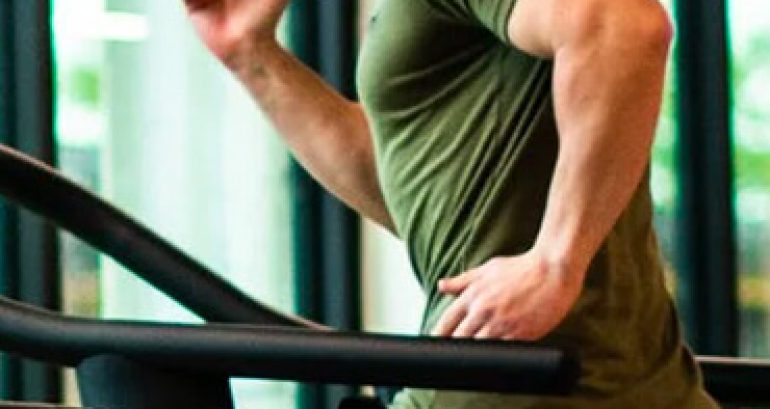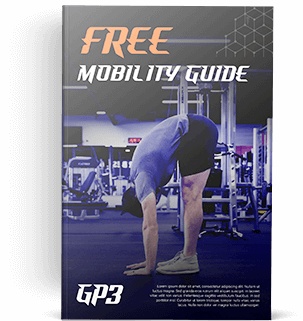Key Points:
1. “Stretching” is a form of strength training.
2. A “tight” muscle is actually just weak in lengthened positions.
3. To strengthen it, use the “Antagonist Contraction Method.”
Estimated reading time: 4-8 minutes
You should stretch more…right? This is one of those unquestioned assumptions nearly everyone feels a little bit guilty about. We all seem to think we should stretch more, and that we’d probably feel better if we did. So, it quietly gnaws at us that we just…don’t stretch very often.
Let me set your mind at ease. You can stop static stretching.
Notice the bolded text, though. You knew there would be a catch, didn’t you?
I’m going to teach you a technique I created, or at least managed to avoid learning from anyone else first, called the Repeated Antagonist Contraction Method. On the surface, it appears very similar to static stretching, but it works much better and more quickly. First, however, let’s look at what stretching is and isn’t, as well as why you probably don’t do it very often.
In your experience, static stretching never really seemed to do much, did it?
I’ll bet this is a huge reason why you don’t stretch very often. While it might make you feel a bit better during a stretching session, the benefits are certainly gone by the next morning. Day after day, stretching routine after stretching routine, nothing really seems to change. I don’t blame you for thinking, “What’s the point?”
Let me confirm your observation. Most static stretching is done at such a low level of intensity that it doesn’t lead to any permanent adaptations. To understand why, we’re going to borrow a concept brilliantly articulated by Keegan Smith of the Athletic Truth Group. Smith encourages us to think of static stretching through a completely different lens. According to him:
“Stretching” is actually strength training.
It makes sense if you think about it. What stretching does is test whether or not the stretched muscle is strong enough to hold the body in the position that lengthens it. Take the classic quad stretch, for example. You know, the one you probably learned in elementary school gym class. Simply stand up, grab one foot near the ankle, and pull it behind your body, feeling the stretch in the front of your thigh.
Compare this to what’s known as the “couch stretch,” which puts your knee into a basically identical position. However, most people find the couch stretch to be way more intense. It’s not even close. As a quick aside, when I first tried to do the couch stretch, I couldn’t lift my torso past a 45-degree angle without sweating and swearing equally profusely from the discomfort.
So, why is that?
Well, with the standing quad stretch, your arms are actually doing most of the work. They’re pulling your leg into a position where the quads are stretched…and yet the quads have to do practically zero active work in holding the stretch. This means your quads don’t get any stronger, and don’t get any better at maintaining the stretched position.
In comparison, during the couch stretch, your quads are working incredibly hard to hold your torso upright. The same holds true for something like the classic legs extended, touch your toes, “Sit & Reach Test” stretch vs. the elephant walk. In the former, you can use your hands and arms to hold the position, lessening the amount of work your hamstrings have to do. In the latter, gravity is helping you a bit, but the rest is pretty much all hamstring, baby.
You see, tightness is actually weakness in disguise.
If you can’t currently touch your toes with perfectly straight legs (and you don’t have a ridiculously short wingspan), it’s because your hamstrings aren’t strong enough to hold that position.
Before you object, let’s return to the example of the standing quad stretch vs. the couch stretch for a moment. Most people, competitive field-sport athletes especially, find the couch stretch to be brutally difficult, even painful, the first time they try it. This is because their quads are too weak to hold their torsos upright in this position.
Hang on a minute, you might be thinking, “I was a high-level soccer/football/lacrosse/whatever player! I do NOT have weak quads!” Before you get too upset with me, I will admit, you’re right. You probably have very strong quads…in the short to mid-range. If you don’t know what I’m talking about, I highly recommend you read this article.
As a quick explanation in case you don’t feel like reading it, your quads are likely weak in the long range (maximally lengthened) position, because your sport and your training never put them there. How often does a competitive sport require you to be in a position like this, where one or both knees are fully bent and your heels are touching your glutes? Basically never. So, because you don’t do that, your quads are weak in the long range position that you never enter.
At least, that’s what your body perceives.
Flexibility and the Brain
Let me explain that last part. You may be surprised to learn that your level of flexibility or range of motion at any joint is almost entirely controlled by the brain and nervous system. If you can’t access a particular range of motion, it’s because the brain doesn’t trust the body to safely get into and out of this position without injuring itself. So, if you’re trying to touch your toes and can’t, that’s your brain saying, “Uhh…don’t do that. We’re going to rip our hamstrings if we go any further.”
This is also why hospitals will secure your arms and legs while you are under anesthesia for surgery. Without the brain and nervous system being active, even the most inflexible person could be folded in half like a lawn chair. Hence, arm and leg straps so you don’t dislocate something. Fascinating, right? At least, I think so.
Luckily, the range of motion your body perceives as safe is actually quite easy to change through training. We’re going to dive deeper into that in a moment, but first we need a quick detour into semi-advanced anatomy and physiology first. Try to contain your excitement, please.
Proprioception
There are specialized cells in your body called proprioceptors. They’re essential for things like balance, in that they help you perceive space, distance, and the stability of a surface, or lack thereof. There are also subtypes of proprioceptors responsible for how much muscular force you can produce. Muscle Spindles sense a stretch in muscle tissue and send feedback to the brain to “unlock” more muscular force in order to overcome whatever is causing the stretch. These cells (plus adrenaline) are partially responsible for those stories we’ve all heard, where a 150 pound mother deadlifts a car or tree off her child.
Golgi Tendon Organs (GTOs) do the opposite. If they sense an amount of stretch that their threshold determines is “too much,” they tell the brain, “shut it down or we’re going to get hurt here!” When this signal is received, the muscle stops producing force in order to prevent the rupture of said muscle or its corresponding connective tissue. Something elite powerlifters can do, through intense, repeated training, is push this threshold further and further. This can be taken too far, and GTOs not activating when they should is partially responsible for the horror stories of strength athletes tearing a quadriceps or pectoral muscle during an powerlifting event.
Okay, lesson over. Now for what to do instead of static stretching.
To increase our range of motion at a given joint, we need to teach the brain, nervous system, and our proprioceptors that we can get into and out of a lengthened position without hurting ourselves. We have four different but related tools that can accomplish this:
- Moving into and out of a lengthened position
- Applying muscular force with an antagonist (opposite) or antagonist-adjacent muscle. (This is the crux of the RAC Method)
- Speed
- Load
We’re going to focus on the first two.
Instead of holding a stretch for a set amount of time, repeatedly move into and out of the “stretch” position. Think of this as “reps.” Stretching is actually strength training, remember? Alternatively, when holding a position, repeatedly flex and relax the opposing muscle. So, when stretching the hamstrings, repeatedly contract the quads. When doing the couch stretch, repeatedly contract the glutes. You can also think of this as performing reps.
Load and speed come into play by serving as intensifiers. If you move in and out of the lengthened position more quickly, it’s more intense and demands more of the stretched muscle. If you do something like place dumbbells on your knees while in the butterfly stretch, it’s more intense and demands more of the adductors (groin). As a word of warning, it’s easy to risk injury by unintentionally overdoing things with load and speed, and even moving into and out of a lengthened position.
This is why I favor tool #2, the RAC Method.
This doesn’t mean I don’t use the other tools; It means I simply start by seeing what I can accomplish by repeatedly applying muscular force with the antagonist. Take the couch stretch, for example. Recall that I said when I first tried this exercise, I could barely lift my torso a foot off the ground. I was able to gradually increase my range of motion, but it was slow and painful, to the point that I eventually gave up.
A couple years later, when I figured out the Repeated Antagonist Contraction method by accident, it was a completely different story. I’d go into the couch stretch position, contract the glutes of my back leg 30 times, and presto! I did that once a day for a little over a month, and I could hold the position with my shoulders touching the wall.
Now, I don’t want to give the impression that static stretching is completely useless. In fact, it’s a great entry point for lengthening and strengthening a particularly deconditioned muscle. We’ve all probably got a particular area of weakness that can initially benefit from static stretching. However, these benefits tend to diminish quickly, since the stimulus static stretching provides simply isn’t large enough to continue strengthening the stretched muscle at length. That’s why we need the RAC method.
Why does the Repeated Antagonist Contraction Method work so well?
The reason this works brings us back to the brain and nervous system. By putting a muscle in whatever its current maximum capacity is for length, then applying muscular force on the opposite side, the brain figuratively sits up and takes notice. It says, “Hmm…that muscle is fully stretched. But, hang on…we’re still strong enough to exert force on the opposite side. And nothing tore? Great! This range of motion must be safe. I’ll tell the proprioceptors to let us get into and out of this position more quickly and smoothly.”
Do this consistently, and it’s almost like leveling up in a video game. Congratulations! You unlocked Rubber Hammies! By utilizing this method wherever you’re tightest (weakest), you’ll be able to perform feats of flexibility like fully touching your palms to the floor with little to no warm up.
All it takes is time and consistency.
Before you go, I’d love to hear from you! Which stretch do you find the hardest or most painful? Let me know so I can send you the best exercise to change that!

